
Hello and welcome to the Weekend Investing Daily Bite for the 1st of April! The market today was quite a rollercoaster, to say the least. It started with a gap down, quickly closed that gap to the upside, and trapped the bears who had positioned themselves both in the morning and from the previous session. Then, in a dramatic turn of events, the market collapsed below the day’s low and ended near its lowest point of the day.
It was certainly not the start one would have hoped for in April, but such volatility is part of the market’s DNA. A looming fear around April 2nd is the potential for reciprocal tariffs from the US, which has been fueling some uncertainty. However, once that fear subsides, we should see more stability return to the market. In addition, the results for the March quarter are coming in the next couple of weeks, and they could serve as the next big trigger for the market. Along with the upcoming interest rate decisions in April, these factors will continue to drive market sentiment.
We’ve had a strong couple of weeks prior to this, but now we’re seeing a correction. The Nifty 50, which is often seen as a leading index, is worth discussing today, especially when it comes to momentum strategies. Many people don’t usually view these indices as momentum-driven, but I’ll show you some data that might change that perspective. The market is increasingly focused on momentum, and understanding this can offer fresh insights into market movements.
Where is the market headed?
Market Overview
Looking at the market performance today, the Nifty 50 was down by about 1.5%. Although the chart might not show it clearly, the market opened lower, recovered briefly, and then collapsed again. The pullback, however, came exactly at the previous pivot, which is an interesting development compared to past patterns. This may signal that we’ve hit a potential bottom, and if this trend holds, we could see the market build upward from here.
That said, there’s still uncertainty. If we break below this level, the trend could remain downward, and today might just have been a brief optimism rally.
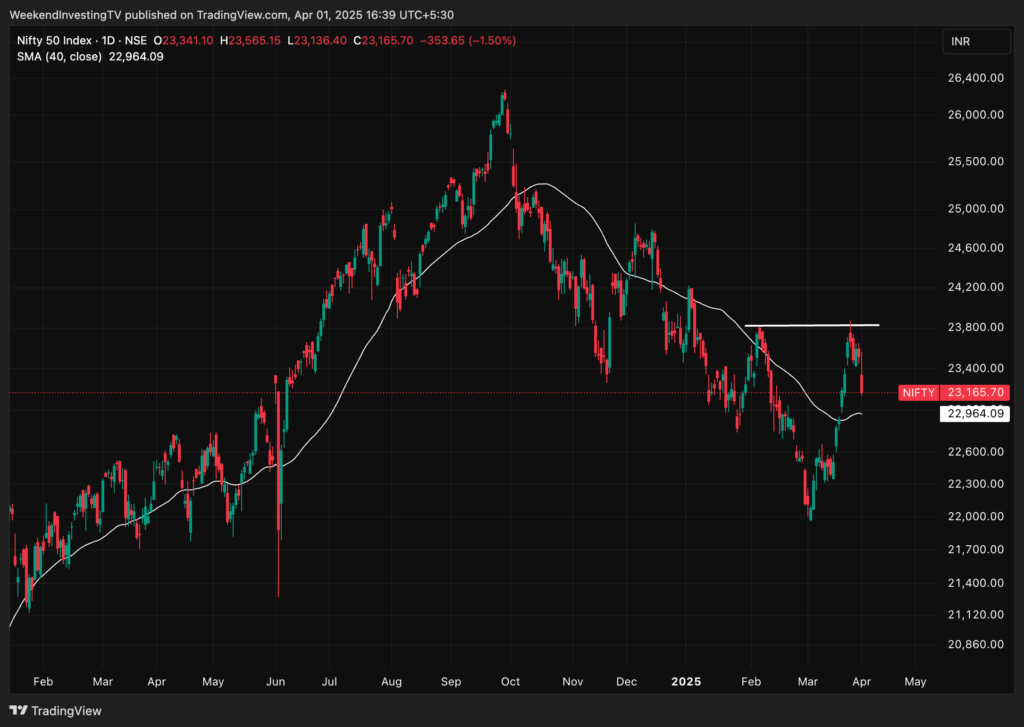
Nifty Next 50
The Nifty Junior index fell by 1.06%
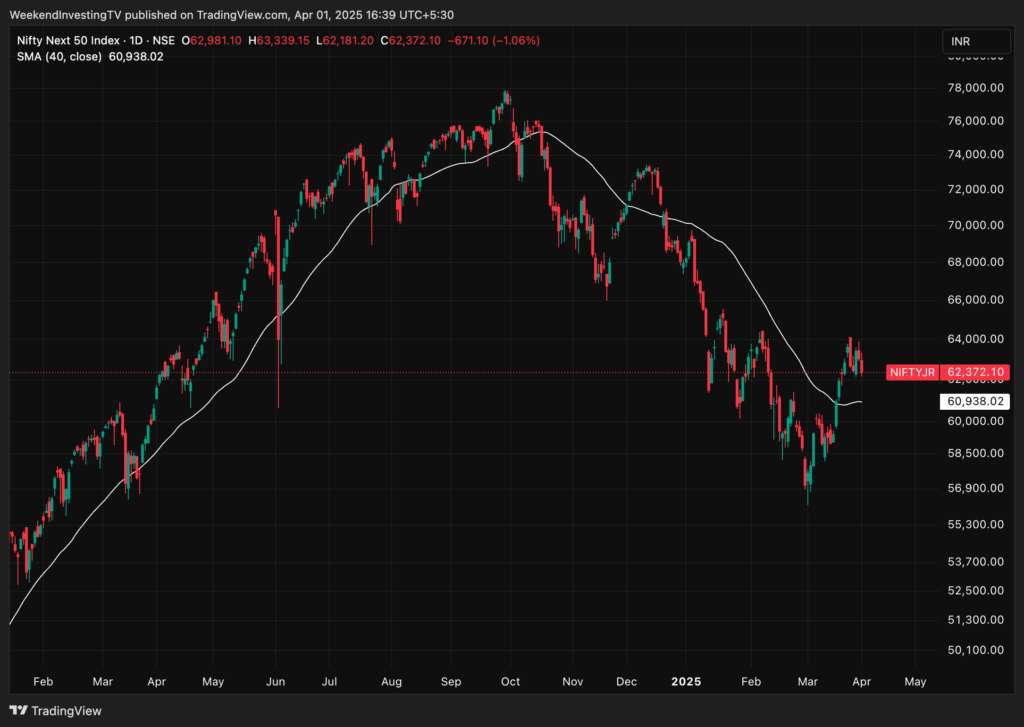
Nifty Mid and Small Cap
While midcaps showed some surprising resilience, only down by about 1%. Small caps were relatively stable, down just 0.5%, which is encouraging. Even though midcaps didn’t fall as much, we are likely seeing heavy FII selling. The data will become clearer later in the evening.
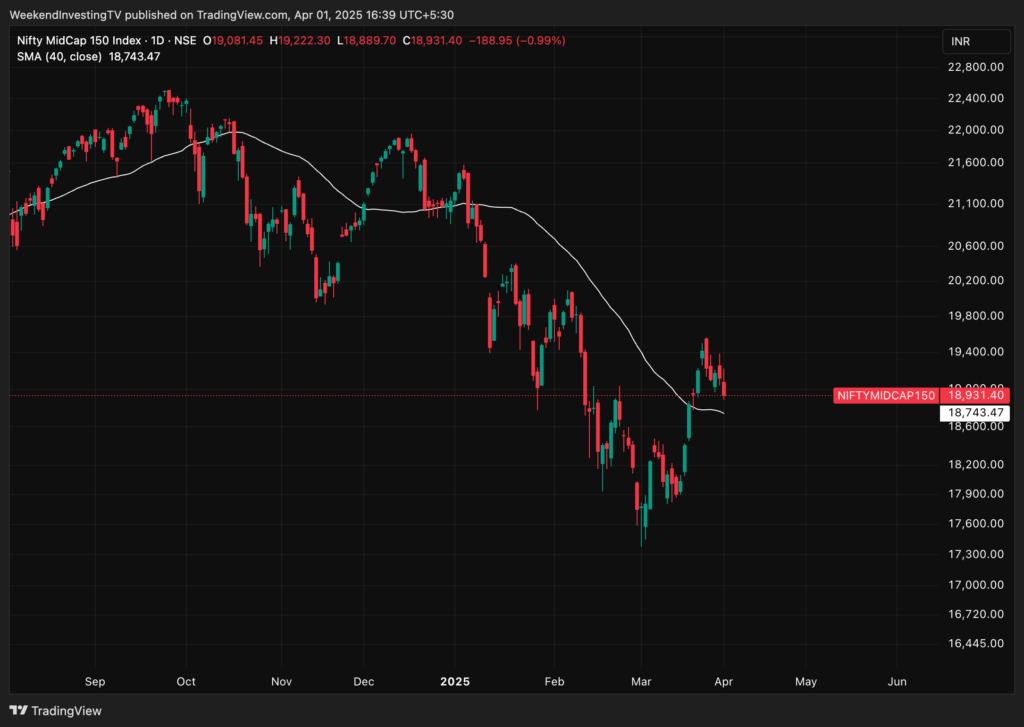
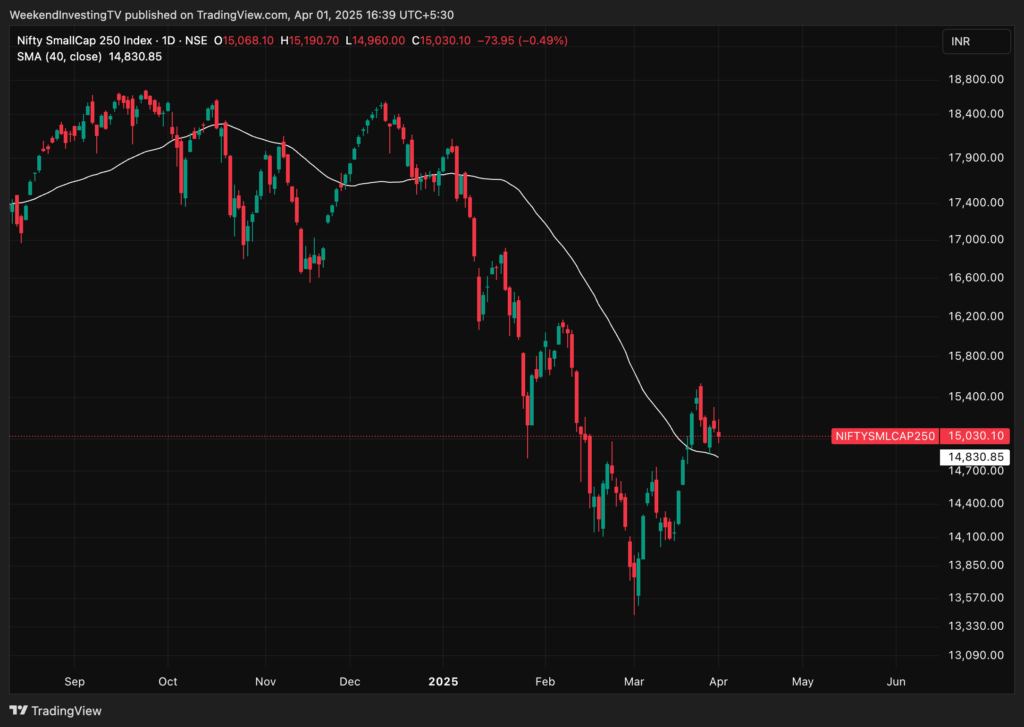
Nifty Bank Overview
Bank Nifty was also down 1.43%, with significant FII action being evident there.

GOLD
On a brighter note, gold was up half a percent, and if we compare it to Friday’s close, it’s up nearly 2.5–3%. This is a typical pattern when market uncertainty rises—gold serves as a hedge, and its performance reflects that well.

Advance Decline Ratio
In terms of market breadth, it wasn’t as bad as it might seem at first glance. The Nifty 500 index had a slight tilt towards the bears, but not overwhelmingly so, with a 205 to 291 ratio. This shows that while the bears were in control, there were still some positive aspects.
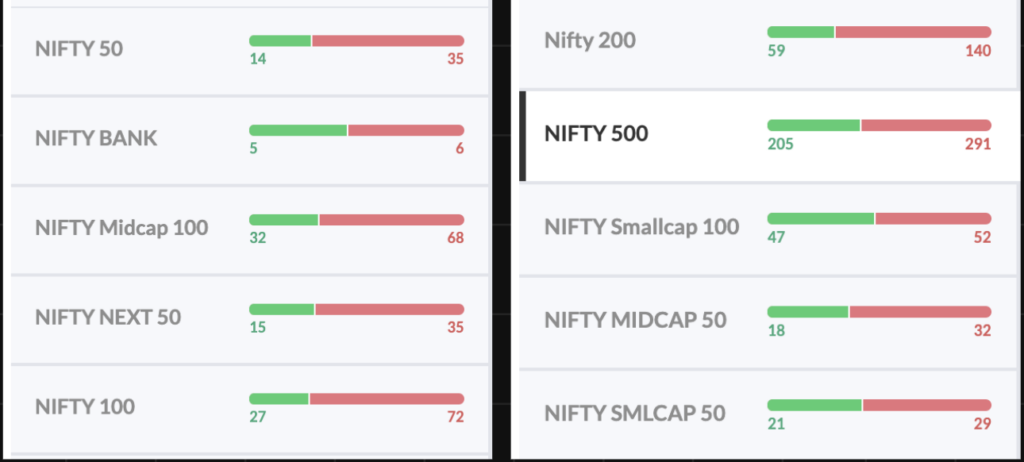
Heat Maps
The heat map of the day showed a significant decline in major stocks like HDFC Bank (down 3.3%), Bajaj Finance (almost 3%), and Bajaj Finserv (down 3.5%). Reliance also saw a decline of 1.7%, while IT stocks, such as Infosys, HCL Tech, TCS, and Tech Mahindra, got hammered. The worst hit were some stocks in the public sector like Bharat Electronics and ITC, while Titan, Sun Pharma, L&T, and Trent showed some resilience.
In the Nifty Next 50 space, we saw even deeper red. Stocks like DLF, Loa Cha Finance, and ABB were hammered, while oil stocks such as IOCL, BPCL, and GAIL held their ground. The PSU banks and public sector enterprises were flat, which, in a day like today, was a saving grace.
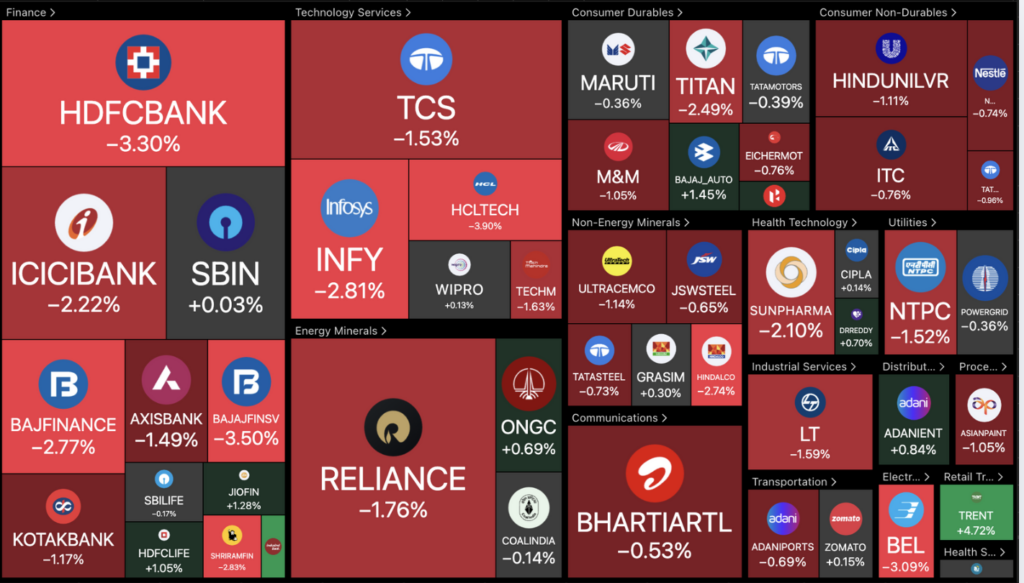
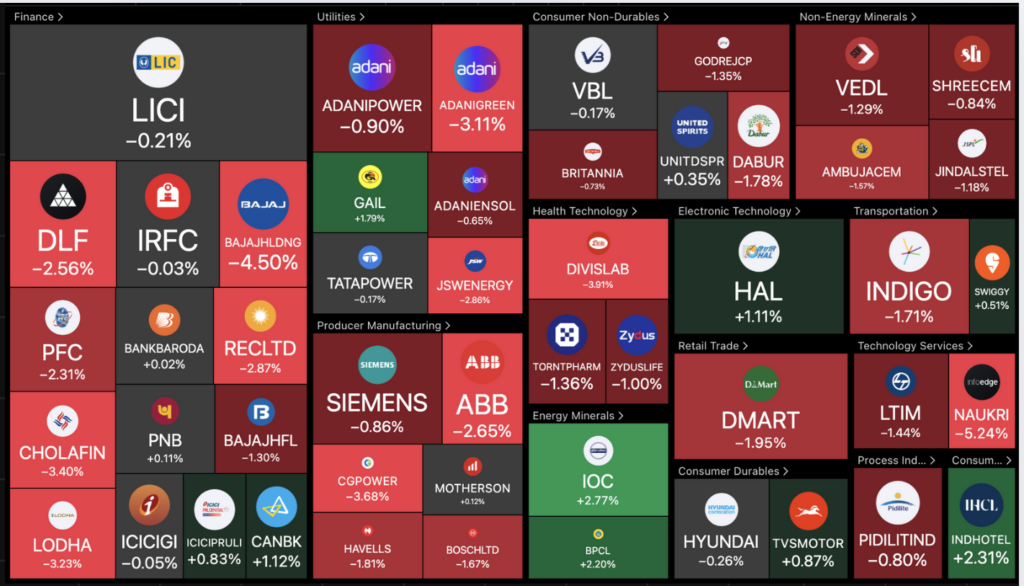
Sectoral Overview
Almost everything within the indices was down today, except for the media sector, which performed exceptionally well, gaining 2.4%. PSU banks remained flat, which was a saving grace on a day like this — at least they didn’t fall. Public Sector Enterprise stocks also held steady.
It seems that the leadership of the market decline is shifting. It’s no longer the public sector stocks that are leading the drop; instead, it’s the IT and real estate sectors that are taking the biggest hits, followed closely by pharma and banking, particularly private banks.
Looking at the past week, the standout performers have been PSU banks and the Nifty Bank index as a whole. On the other hand, sectors like real estate, pharma, and autos have taken the hardest losses.
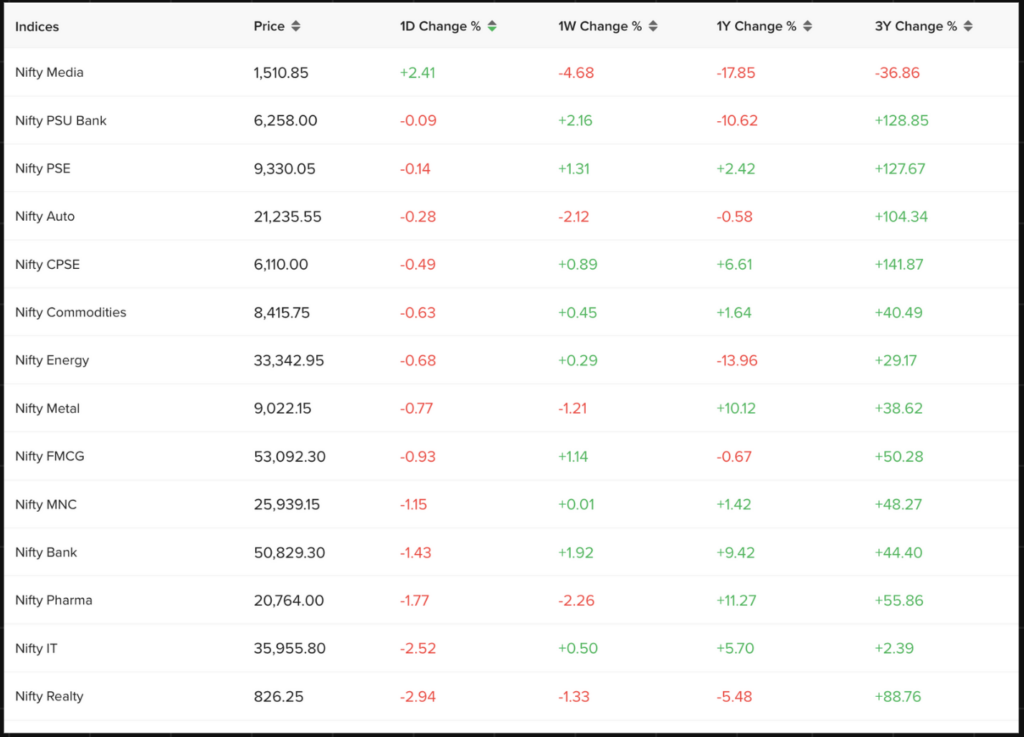
Sectors of the Day
Nifty Media Index
Notably, some media stocks like Dish TV, PVR, and Zee Entertainment saw significant gains today, and they’re all now closely tracking the 40-day moving average on the Nifty Media Index.
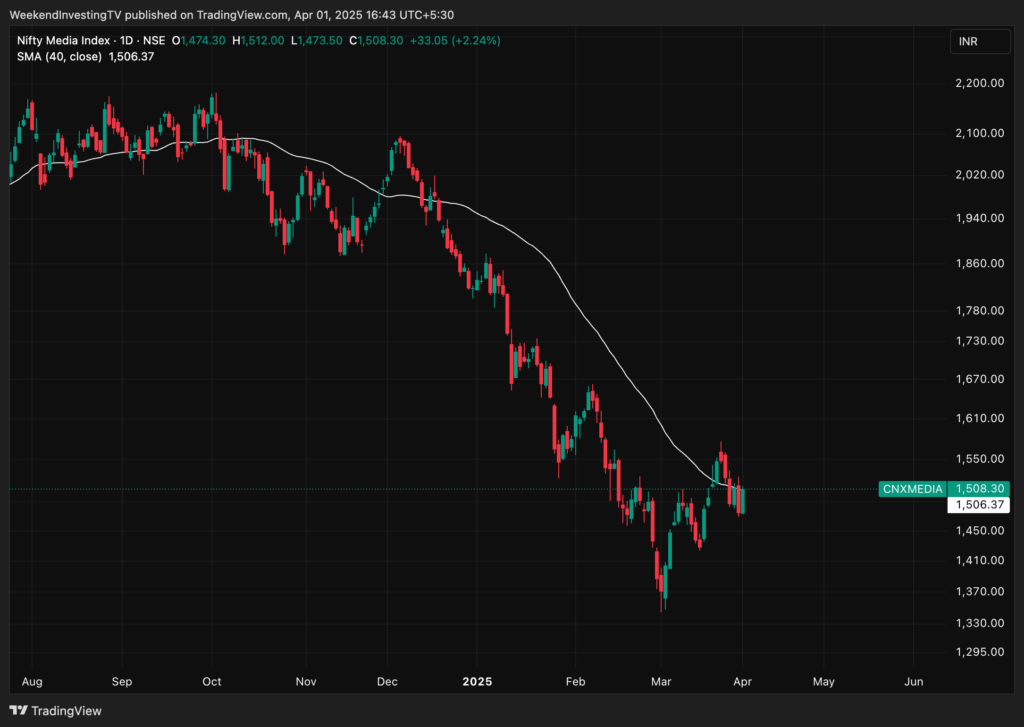
Story of the Day
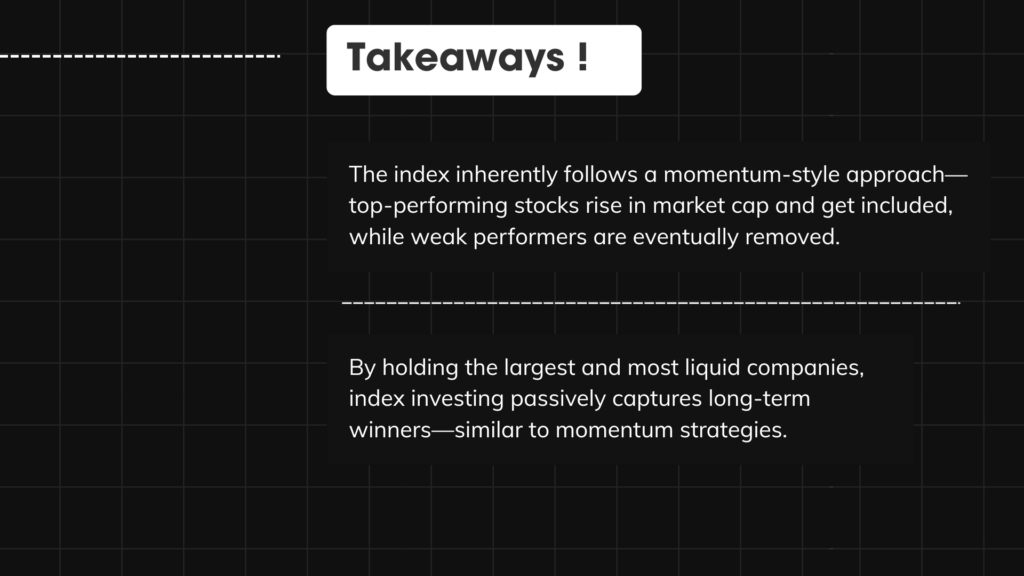
A Quick Look at Recent Trends
We’ve had some fantastic weeks leading up to this, but now we’re in a corrective phase. This brings me to the Nifty 50 and its momentum strategy, which I’d like to briefly discuss today. Many people don’t view the indices as momentum-based, so I’ll show you some data and a perspective where you might begin to appreciate that the entire market is geared towards momentum.
Before we dive in, please do read the disclaimer at the end of this post and fully understand the clauses. Also, if you haven’t already, please subscribe to the channel.
The Semi-Annual Index Rejig
You must have heard about the recent semi-annual index rejig. Every six months, all indices (for example, those on the National Stock Exchange) are reviewed and changed. A circular comes out from the exchange, announcing the new index for the period starting from April 1st. Some stocks are included, and some stocks are removed.
This time around, Zomato and Jio Financial Services have been included in the Nifty, while BPCL and Britannia have been removed. In addition to the Nifty, there are other indices like Nifty CNX 200, Mid and Small Cap 400, Small Cap 250, and Nifty Next 50, to name just a few.
Does Momentum Work?
Now, a common question that arises is: Does momentum work? And that brings us to the connection between index rebalancing and momentum as a strategy. I believe that the index itself operates as a momentum strategy. Here’s why:
Index as a Momentum Strategy
What is the essence of a momentum strategy? It’s about riding winners and letting go of losers. In its simplest form, a momentum strategy focuses on staying with stocks that are moving higher, while avoiding those that are losing momentum.
The index, particularly the Nifty 50, is geared towards a similar approach. It’s a long-only strategy that “rides” the winners. Every six months, the index committee reviews the stocks and determines which ones should “survive.” If a stock outside the index is performing better and has a better chance of moving the index forward, it gets included. Conversely, stocks that aren’t performing well enough are removed.
For example, BPCL and Britannia were removed from the Nifty. While they are excellent companies, they’ve been underperforming relative to other stocks in the market.
The main criteria for inclusion and exclusion are free float market capitalization, liquidity, and trading volumes. If a company outside the Nifty starts to perform better and meets these criteria, it will find its place in the index. So, Zomato, for example, has been included because of its strong performance.
The Evolution of Stock Movement Through Indices
The Nifty sits at the top of the index hierarchy, followed by Nifty Next 50, Mid Cap, Small Cap, and Micro Cap indices. Stocks move up or down through these indices based on their performance.
For example, Yes Bank was once in the Nifty. But after a significant collapse in value, it dropped to a small cap, demonstrating how stocks can rise and fall through these indices based on performance.
The entire process is similar to “survival of the fittest.” Every six months, the index committee decides which stocks should remain in the index, and which should be removed. The stocks that are performing well survive, while the underperforming ones are left behind.
Why Momentum Works in the Index
Let’s think about it: rising stocks lead to a higher market capitalization, which increases their chances of being included in the index. This process is inherently momentum-based. You’re essentially nurturing outperformance and getting rid of underperformance.
But there’s an irony here. When stocks enter the Nifty, they often get over-researched and over-owned by fund managers. This can sometimes dampen their performance. On the flip side, stocks that leave the Nifty sometimes perform better post-exit. This creates a cycle where the stocks that enter the index due to their performance may lose their edge once the spotlight is on them.
Examples of Index Stocks and Their Journey
Let’s take a few examples of stocks that entered and exited the Nifty:
- Yes Bank: It entered the Nifty in 2011 after a remarkable 6x gain in just two years. However, by 2020, the stock had fallen by 98%, and it was eventually removed from the Nifty.
- Reliance Communication: This stock entered the Nifty when it was trading around ₹750. But after a major collapse to ₹92, it was removed from the index.
- Zee Entertainment: Zee entered the Nifty in 2017 after strong performance, but then saw a 75% decline before being removed in 2020.
These examples show that stocks can enter the Nifty based on hype or strong performance, only to underperform later. Meanwhile, stocks that exit the index can sometimes rebound, as they no longer face the same level of scrutiny.
What Does This Mean for Investors?
The key takeaway here is that the index itself operates as a momentum strategy. It’s designed to reward the best-performing stocks and remove the underperformers. However, the index may hold on to underperforming stocks longer than ideal.
This is where a momentum strategy can give individual investors an advantage. By using momentum as your core strategy, you can exit underperforming stocks before they get removed from the index, rather than waiting for the index committee to make the change.
Additionally, momentum strategies avoid the issue of a few heavyweight stocks disproportionately impacting the index. The Nifty, for example, is heavily weighted towards sectors like banking and finance. A momentum strategy would spread the risk more evenly, as it doesn’t rely so heavily on a few sectors.
Conclusion: Is Momentum Investing for You?
Momentum investing is simple in theory but not always easy to execute. It requires discipline, a clear strategy, and the ability to follow the market’s natural ebb and flow. But, if executed correctly, it can provide a smoother and more profitable ride than traditional index investing.
Momentum investing works because it’s built on a solid strategy that rewards winners while cutting losers. It’s a strategy that works in sync with the market’s natural cycles, and with the right approach, it can offer a steady path to success without the emotional rollercoaster that often comes with other investing strategies.
WeekendInvesting launches – The Momentum Podcast
Get ready to dive into an inspiring investing tale!
Join us on WeekendInvesting’s The Momentum Podcast Epsiode 1 as Mr. Yassar, a Dubai-based engineer-turned-investor, reveals his 15-year journey—from Wall Street fascination to mastering systematic trading.
Hear Alok and Yassar talk about Real estate, Gold, Crypto and many hard-earned lessons, and practical tips for navigating markets.
Disclaimers and disclosures : https://tinyurl.com/2763eyaz






